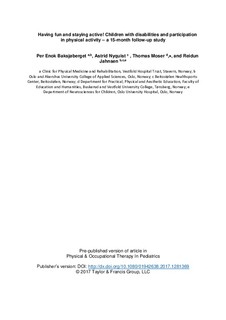| dc.contributor.author | Baksjøberget, Per Enok | |
| dc.contributor.author | Nyquist, Astrid | |
| dc.contributor.author | Moser, Thomas | |
| dc.contributor.author | Jahnsen, Reidun | |
| dc.date.accessioned | 2018-01-23T11:49:40Z | |
| dc.date.available | 2018-01-23T11:49:40Z | |
| dc.date.created | 2017-03-21T10:59:01Z | |
| dc.date.issued | 2017 | |
| dc.identifier.citation | Physical and Occupational Therapy in Pediatrics. 2017, 37 (4), 347-358. | nb_NO |
| dc.identifier.issn | 0194-2638 | |
| dc.identifier.uri | http://hdl.handle.net/11250/2479033 | |
| dc.description.abstract | Aim: This study investigated change in the participation profile of physical activity over 15 months after a three-week intensive rehabilitation that used physical activity as the main intervention. Methods: The Children's Assessment of Participation and Enjoyment (CAPE) was used in a longitudinal prospective study (pre- and post-design) with three measurements over 15 months. Eighty children with physical disabilities (6–17 years old; mean score 11.1; SD 2.4), some with additional cognitive challenges, completed all three measurements. Results: Participation diversity and intensity of all 55 leisure activities declined significantly over the 15-month period. The largest decline was for children aged between 10 and 13 years. Among physical activities, there was a stable level of participation of the total group, and sub-groups. Boys preferred “active physical activities” to a greater extent, while girls preferred “skill-based activities.” Both genders expressed a higher level of enjoyment in their preferred activities according to the Preferences for Activities of Children. Conclusions: This intervention may have the potential to maintain the level of physical activity among children and youths with disabilities, yet further controlled studies are needed. Gender differences should be taken into consideration to facilitate stable participation in physical activities with a high level of enjoyment. | nb_NO |
| dc.language.iso | eng | nb_NO |
| dc.title | Having Fun and Staying Active! Children with Disabilities and Participation in Physical Activity: A 15th-month Follow-Up Study | nb_NO |
| dc.type | Journal article | nb_NO |
| dc.type | Peer reviewed | nb_NO |
| dc.description.version | acceptedVersion | nb_NO |
| dc.rights.holder | © 2017 Taylor & Francis Group | nb_NO |
| dc.source.pagenumber | 347-358 | nb_NO |
| dc.source.volume | 37 | nb_NO |
| dc.source.journal | Physical and Occupational Therapy in Pediatrics | nb_NO |
| dc.source.issue | 4 | nb_NO |
| dc.identifier.doi | 10.1080/01942638.2017.1281369 | |
| dc.identifier.cristin | 1459939 | |
| cristin.unitcode | 222,59,7,0 | |
| cristin.unitname | Institutt for pedagogikk | |
| cristin.ispublished | true | |
| cristin.fulltext | postprint | |
| cristin.qualitycode | 1 | |
